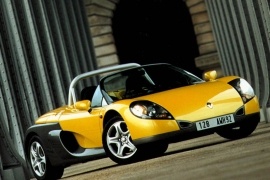RENAULT Spider Models/Series Timeline, Specifications & Photos
First production year: 1996
Engines: Gasoline
Body style: Convertible (spider/spyder, cabrio/cabriolet, drop/open/soft top)
Renault introduced a unique car on the market in 1990, a car that looked like anything else rather than a Renault; it was the Renault Sport Spider.
First of all, it has to be clear that Renault Sport was a completely different breed than the mainstream French carmaker. Even though it was part of Renault, it traced its roots in the Alpine sports car manufacturer. It didn't care about fuel efficiency, comfortable seats, or trunk space. All it cared for was performance, and the Renault Sport Spider was precisely that kind of vehicle.
Without a roof above the car and an option for a windshield, the Spider was a track-day car allowed to wear license plates. The short front side of the vehicle had a tiny storage area suitable for a helmet, a pair of headlights covered by clear glass, and two small air-scoops. On its sides, behind the Lambo-style doors, the car manufacturer installed big air-intakes for the engine. An aluminum roll-bar stood straight behind the cockpit, and a flat lid covered the powerplant.
There were two Recaro sport bucket seats, a steering wheel, and an instrument cluster. On the center stack, there were two buttons: one for the hazard lights and the other for windshield heating (if fitted). In front of the driver, Renault Sport installed a three-dial instrument panel which showed the tachometer, the oil pressure, and the water (coolant) temperature. In addition, the carmaker installed the speedometer and the fuel level on a separate LCD panel placed on top of the dashboard, far from the driver.
Behind the cockpit, the 2.0-liter powerplant was carried over from the Renault Clio Williams and developed 150 hp. That might not seem too much, but the entire car weighed just 955 kilos (2,106 lbs.)
